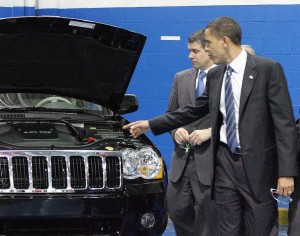In a move fraught with political overtones, President Barack Obama will visit a Chrysler Group plant in Toledo, Ohio today to hail the ongoing recovery of the once-bankrupt automaker, which has now posted 14 consecutive months of sales growth and is preparing to sever its ties with the government.
The president’s visit, meanwhile, comes just after the automaker finished paying off its federal loans, with Fiat now preparing to buy out the Treasury Department’s remaining 6.6% stake in Chrysler, cutting its ties to the government.
The Obama administration has made no secret of the fact it considers the bailout to have been an immense success – despite the fact that the White House also disclosed this week it expects $14 billion of the $80 billion advanced Chrysler and General Motors will not be recovered by the U.S. Treasury.
At least initially, the rescue efforts were largely unpopular with the taxpaying public, so the Administration is hoping to focus on the payoff – with an emphasis on jobs. The White House has argued that despite the costs the bailout probably saved as many as 1 million jobs and helped stabilized America’s manufacturing sector at a time when it was teetering on the brink of disasters.
Ron Bloom , one of the principle architects of the bailout who is now a White House counselor, told a White House briefing this week that the administration considers the money well spent and noted Chrysler faced being dismantled without the federal intervention.
“When the President took office, we had an automobile industry in absolute freefall,” said Bloom. “The President faced very difficult decisions about what to do to deal with this critical part of the American economy,” Bloom said.
“Since that time, I think we’ve seen some really positive and encouraging signs, and we think that at this two-year anniversary it’s reasonable to kind of take note and account of those things,” he said.
The president’s visit to the Jeep plant in Toledo comes almost exactly two years after Chrysler emerged from Chapter 11 protection. And while the overall U.S. economy has been struggling since then, the picture has largely improved for all the American makers, not just Chrysler.
“In the last year, the Detroit Three have all gained market share, they have all added jobs, and they’ve all shown the ability to make money,” Bloom said, adding that, “the credit for that importantly goes to the men and women of those companies and their stakeholders, who all made very, very difficult decisions to come together,” Bloom said.
The effort to rescue General Motors and Chrysler actually began under the administration of former Pres. George W. Bush but, following the failure of Congress to approve a broader bailout, the effort was turned over to the new White House occupant. And while there was clear administration support for saving GM, offering billions to rescue Chrysler was more controversial, recalled Bloom.
“In particular,r I think Chrysler was, in fact, a difficult call,” Bloom said. “At the time the President chose to help Chrysler, at the time he chose to help General Motors, a lot of people said, you’re throwing good money after bad; you’ll never get out; these companies are not savable.
But I think the President demonstrated both great political courage as well as great faith in the men and women who work at these companies and their stakeholders, and, so far, at least, I think we’re seeing very good signs of progress. As I said, employment up — the industry has gained 115,000 jobs in the last year, fastest job growth in a long, long time,” said Bloom, noting Fiat has now invested $1.3 billion in Chrysler.
Over the past month, much to the discomfort of critics of the bailout, the White House has used each step Chrysler has taken , from the successful sale of bonds to private investors to the actual re-payment of the loans last week, to promote the overall success of the bailout.
The White House campaign began in late April when Secretary of the Treasury Timothy Geithner visited Detroit and hailed the recovery of both Chrysler and GM.
Chrysler has added more than 2,000 employees since early 2010 in engineering and technical fields as well as in areas such as finance and marketing. The surge in employment has prompted Chrysler to look for local office space outside the automaker’s sprawling headquarters and technical complex in Auburn Hills.
In addition, the Chrysler assembly plant in Sterling Heights, which was scheduled to close permanently, has been given a new lease of life. The Jeep plant in Detroit, meanwhile, has expanded its workforce to handle strong demand for products like the new Grand Cherokee, a finalist for North American Car of the Year.
GM, thanks to the bailout, is also re-tooling many of its North American plants, at a cost of billions. Its assembly plant in Orion Township is notably gearing up to build a new family of small cars that had, in the past, been produced in China. That move saved approximately 1,200 job. GM also is preparing to add production shifts at assembly plants in Flint and Detroit.
Nevertheless, critics of the bailout contend that Obama trampled on the rights of bondholders and gave preference to the interests of members of the United Auto Workers.
Federal courts have sanctioned the bailout but the U.S. Supreme Court declined to hear an appeal from the bondholders, who complained their rights were violated during the government-sponsored re-organization.
Unionized workers at Chrysler and General Motors, while keeping pension and health care benefits, gave up promised pay increases under the terms of the bailout agreement and also gave up the right to strike – a decision that could come into play as they set out to negotiate new contracts with GM and Chrysler – as well as Ford – this summer. Critics nonetheless argue a “non-political” bankruptcy would have forced the UAW to make greater concessions in key areas such as health care benefits.

